MGNT 803: Analysis of Organisational Culture and Management Report
VerifiedAdded on 2022/10/12
|7
|2113
|258
Report
AI Summary
This report examines the significance of organizational culture in defining success and achieving objectives. It explores the impact of culture on employee satisfaction, firm performance, and customer relations, drawing insights from various sources including Warrick (2016), TĂNASE (2015), and Dasgupta (2014). The report defines organizational culture, its components, and its role in supporting organizational changes. It also highlights the practical implications for managers, emphasizing the importance of fostering a positive, adaptive culture through training, monitoring, and aligning organizational objectives with employee values. The report concludes by summarizing key learnings and emphasizing the central role of culture in driving sustainable growth and business success. It also provides references to the sources used in the analysis.
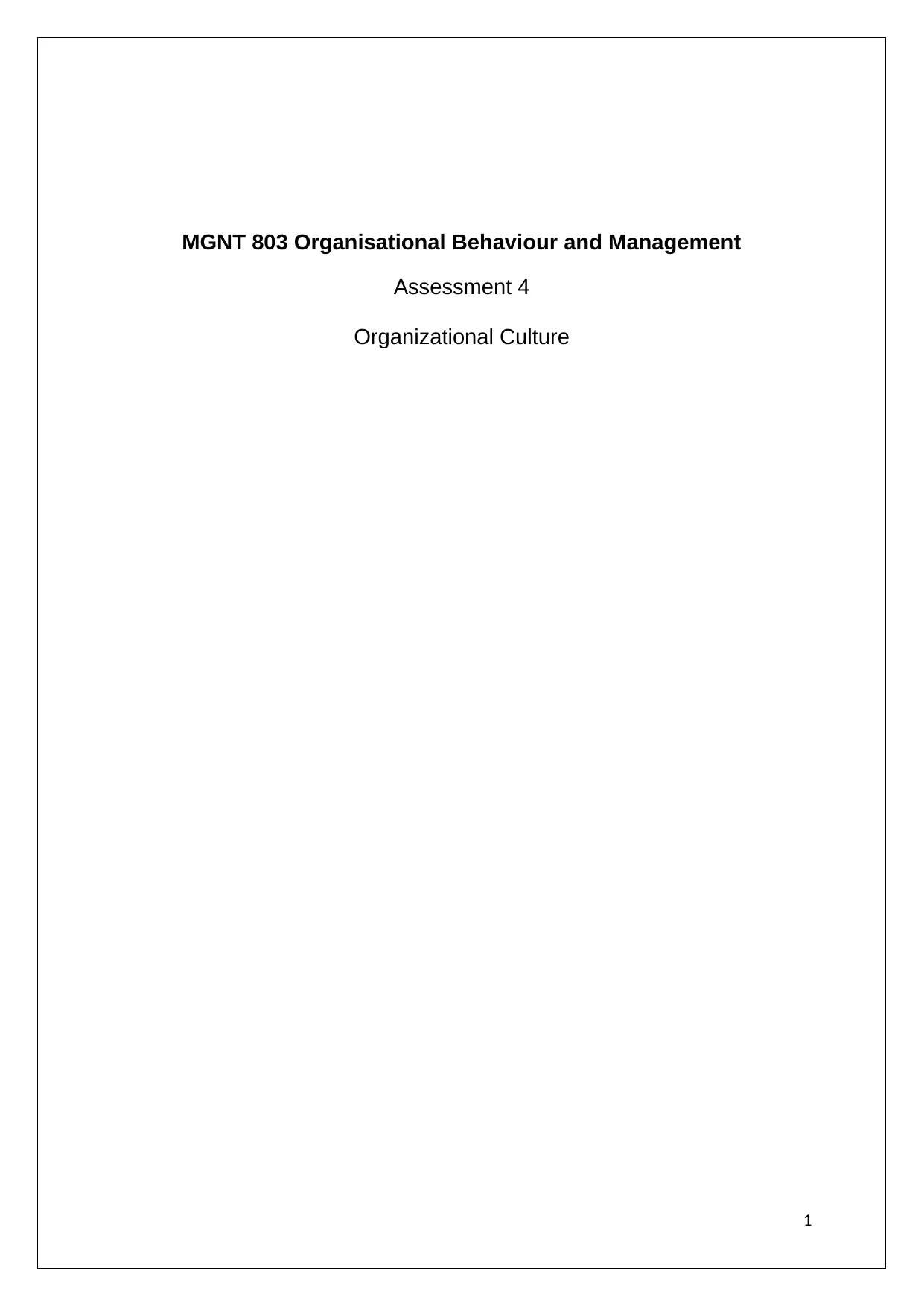
MGNT 803 Organisational Behaviour and Management
Assessment 4
Organizational Culture
1
Assessment 4
Organizational Culture
1
Paraphrase This Document
Need a fresh take? Get an instant paraphrase of this document with our AI Paraphraser
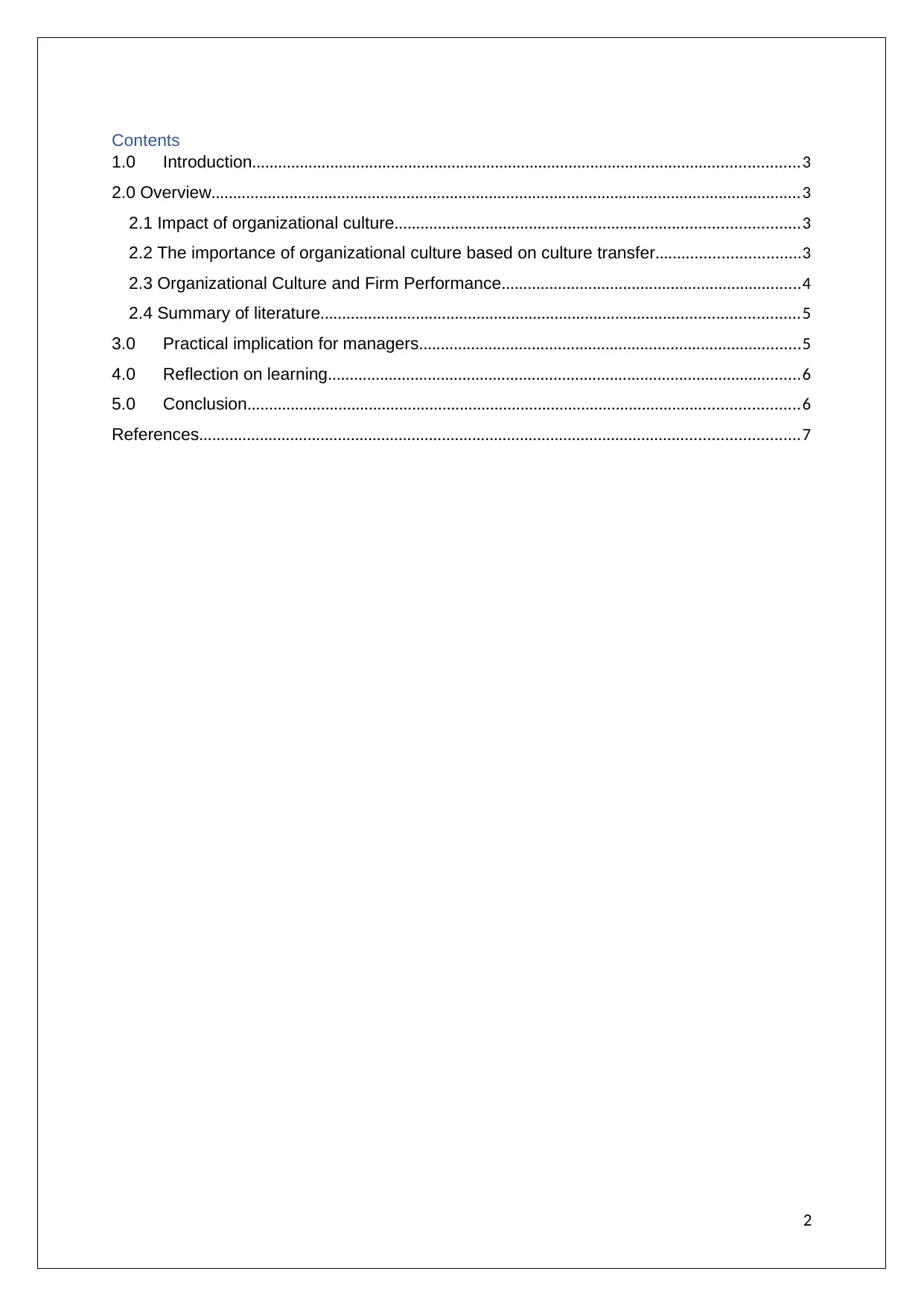
Contents
1.0 Introduction..............................................................................................................................3
2.0 Overview........................................................................................................................................3
2.1 Impact of organizational culture.............................................................................................3
2.2 The importance of organizational culture based on culture transfer.................................3
2.3 Organizational Culture and Firm Performance.....................................................................4
2.4 Summary of literature..............................................................................................................5
3.0 Practical implication for managers........................................................................................5
4.0 Reflection on learning.............................................................................................................6
5.0 Conclusion...............................................................................................................................6
References..........................................................................................................................................7
2
1.0 Introduction..............................................................................................................................3
2.0 Overview........................................................................................................................................3
2.1 Impact of organizational culture.............................................................................................3
2.2 The importance of organizational culture based on culture transfer.................................3
2.3 Organizational Culture and Firm Performance.....................................................................4
2.4 Summary of literature..............................................................................................................5
3.0 Practical implication for managers........................................................................................5
4.0 Reflection on learning.............................................................................................................6
5.0 Conclusion...............................................................................................................................6
References..........................................................................................................................................7
2
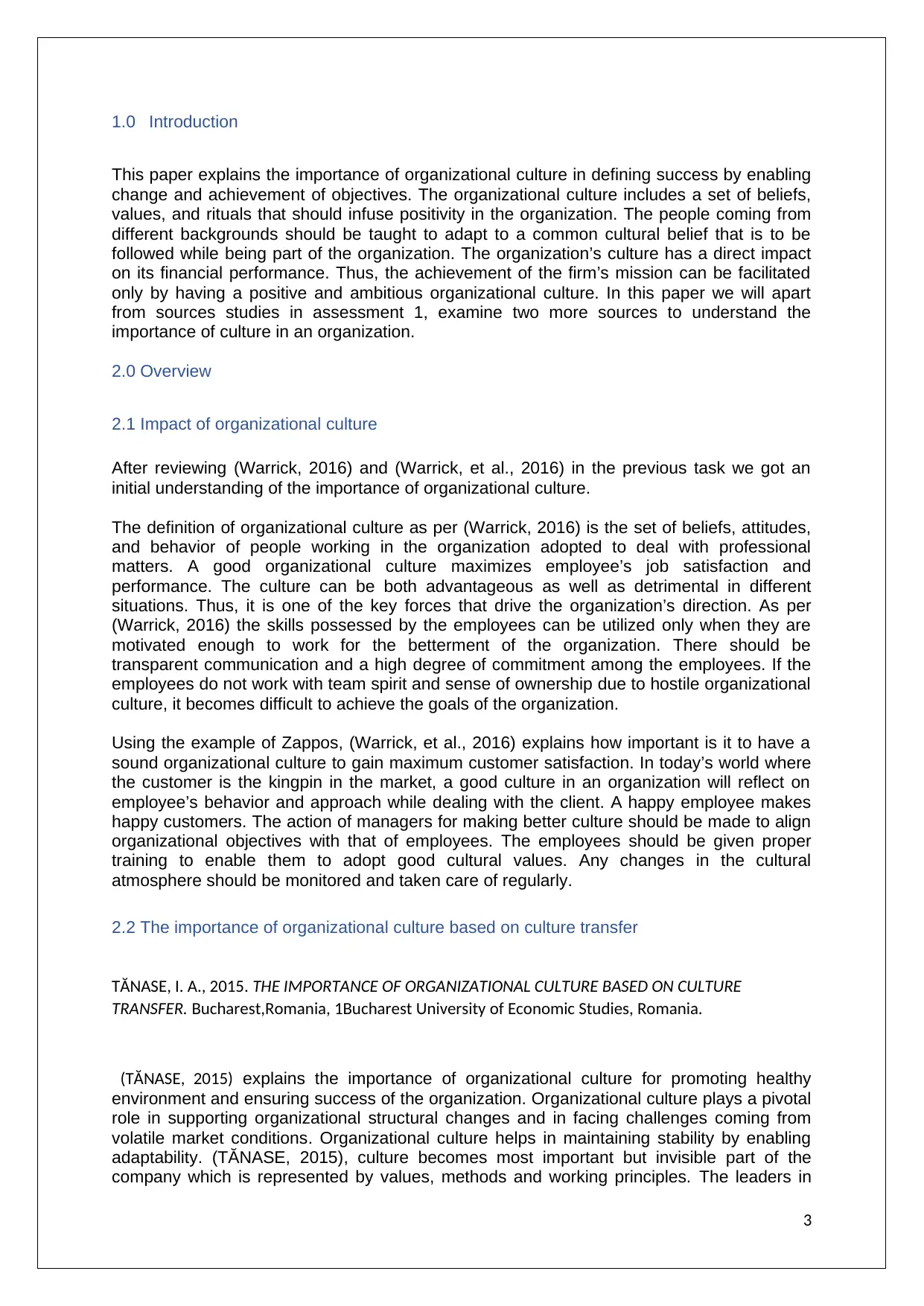
1.0 Introduction
This paper explains the importance of organizational culture in defining success by enabling
change and achievement of objectives. The organizational culture includes a set of beliefs,
values, and rituals that should infuse positivity in the organization. The people coming from
different backgrounds should be taught to adapt to a common cultural belief that is to be
followed while being part of the organization. The organization’s culture has a direct impact
on its financial performance. Thus, the achievement of the firm’s mission can be facilitated
only by having a positive and ambitious organizational culture. In this paper we will apart
from sources studies in assessment 1, examine two more sources to understand the
importance of culture in an organization.
2.0 Overview
2.1 Impact of organizational culture
After reviewing (Warrick, 2016) and (Warrick, et al., 2016) in the previous task we got an
initial understanding of the importance of organizational culture.
The definition of organizational culture as per (Warrick, 2016) is the set of beliefs, attitudes,
and behavior of people working in the organization adopted to deal with professional
matters. A good organizational culture maximizes employee’s job satisfaction and
performance. The culture can be both advantageous as well as detrimental in different
situations. Thus, it is one of the key forces that drive the organization’s direction. As per
(Warrick, 2016) the skills possessed by the employees can be utilized only when they are
motivated enough to work for the betterment of the organization. There should be
transparent communication and a high degree of commitment among the employees. If the
employees do not work with team spirit and sense of ownership due to hostile organizational
culture, it becomes difficult to achieve the goals of the organization.
Using the example of Zappos, (Warrick, et al., 2016) explains how important is it to have a
sound organizational culture to gain maximum customer satisfaction. In today’s world where
the customer is the kingpin in the market, a good culture in an organization will reflect on
employee’s behavior and approach while dealing with the client. A happy employee makes
happy customers. The action of managers for making better culture should be made to align
organizational objectives with that of employees. The employees should be given proper
training to enable them to adopt good cultural values. Any changes in the cultural
atmosphere should be monitored and taken care of regularly.
2.2 The importance of organizational culture based on culture transfer
TĂNASE, I. A., 2015. THE IMPORTANCE OF ORGANIZATIONAL CULTURE BASED ON CULTURE
TRANSFER. Bucharest,Romania, 1Bucharest University of Economic Studies, Romania.
(TĂNASE, 2015) explains the importance of organizational culture for promoting healthy
environment and ensuring success of the organization. Organizational culture plays a pivotal
role in supporting organizational structural changes and in facing challenges coming from
volatile market conditions. Organizational culture helps in maintaining stability by enabling
adaptability. (TĂNASE, 2015), culture becomes most important but invisible part of the
company which is represented by values, methods and working principles. The leaders in
3
This paper explains the importance of organizational culture in defining success by enabling
change and achievement of objectives. The organizational culture includes a set of beliefs,
values, and rituals that should infuse positivity in the organization. The people coming from
different backgrounds should be taught to adapt to a common cultural belief that is to be
followed while being part of the organization. The organization’s culture has a direct impact
on its financial performance. Thus, the achievement of the firm’s mission can be facilitated
only by having a positive and ambitious organizational culture. In this paper we will apart
from sources studies in assessment 1, examine two more sources to understand the
importance of culture in an organization.
2.0 Overview
2.1 Impact of organizational culture
After reviewing (Warrick, 2016) and (Warrick, et al., 2016) in the previous task we got an
initial understanding of the importance of organizational culture.
The definition of organizational culture as per (Warrick, 2016) is the set of beliefs, attitudes,
and behavior of people working in the organization adopted to deal with professional
matters. A good organizational culture maximizes employee’s job satisfaction and
performance. The culture can be both advantageous as well as detrimental in different
situations. Thus, it is one of the key forces that drive the organization’s direction. As per
(Warrick, 2016) the skills possessed by the employees can be utilized only when they are
motivated enough to work for the betterment of the organization. There should be
transparent communication and a high degree of commitment among the employees. If the
employees do not work with team spirit and sense of ownership due to hostile organizational
culture, it becomes difficult to achieve the goals of the organization.
Using the example of Zappos, (Warrick, et al., 2016) explains how important is it to have a
sound organizational culture to gain maximum customer satisfaction. In today’s world where
the customer is the kingpin in the market, a good culture in an organization will reflect on
employee’s behavior and approach while dealing with the client. A happy employee makes
happy customers. The action of managers for making better culture should be made to align
organizational objectives with that of employees. The employees should be given proper
training to enable them to adopt good cultural values. Any changes in the cultural
atmosphere should be monitored and taken care of regularly.
2.2 The importance of organizational culture based on culture transfer
TĂNASE, I. A., 2015. THE IMPORTANCE OF ORGANIZATIONAL CULTURE BASED ON CULTURE
TRANSFER. Bucharest,Romania, 1Bucharest University of Economic Studies, Romania.
(TĂNASE, 2015) explains the importance of organizational culture for promoting healthy
environment and ensuring success of the organization. Organizational culture plays a pivotal
role in supporting organizational structural changes and in facing challenges coming from
volatile market conditions. Organizational culture helps in maintaining stability by enabling
adaptability. (TĂNASE, 2015), culture becomes most important but invisible part of the
company which is represented by values, methods and working principles. The leaders in
3
⊘ This is a preview!⊘
Do you want full access?
Subscribe today to unlock all pages.

Trusted by 1+ million students worldwide
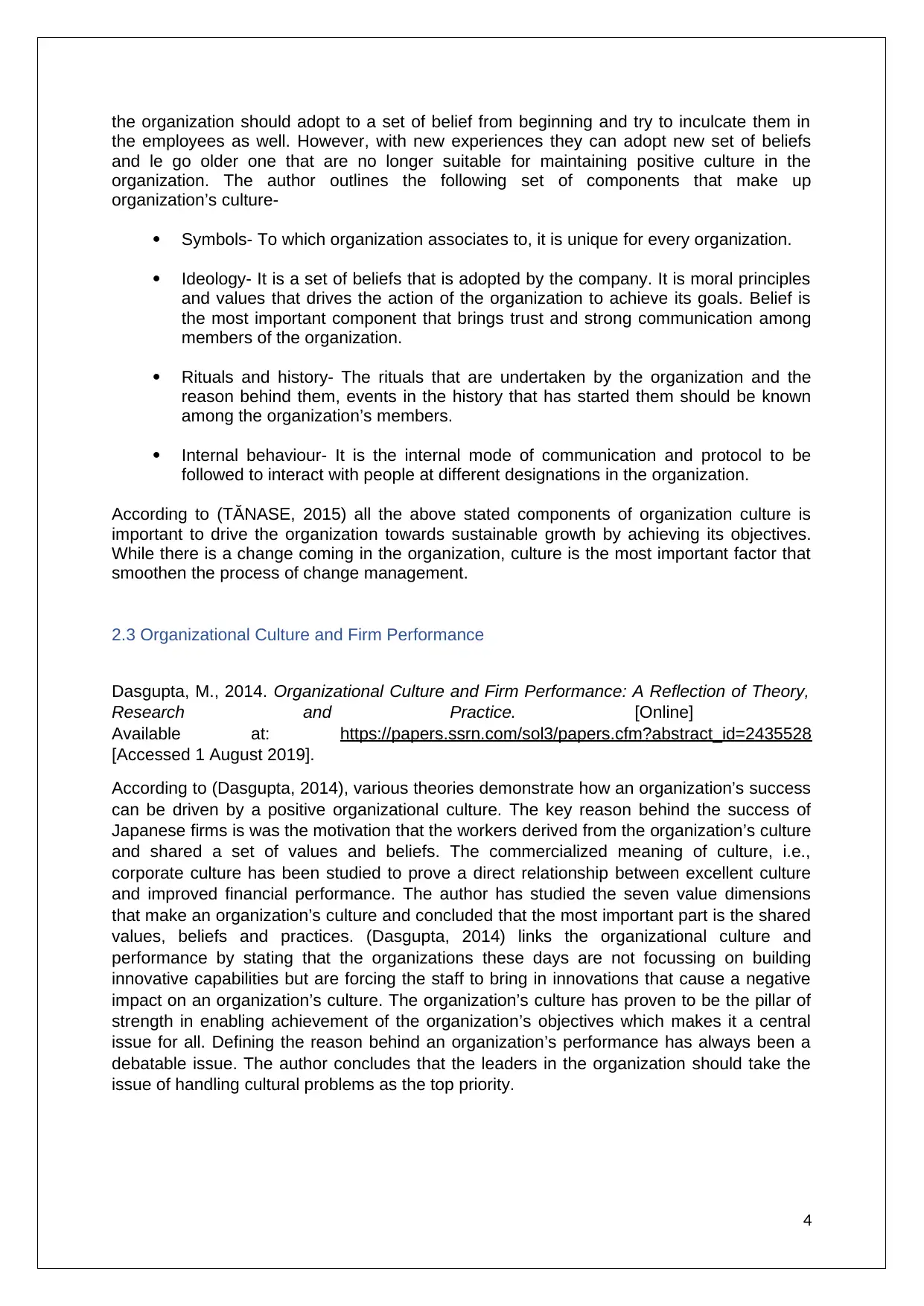
the organization should adopt to a set of belief from beginning and try to inculcate them in
the employees as well. However, with new experiences they can adopt new set of beliefs
and le go older one that are no longer suitable for maintaining positive culture in the
organization. The author outlines the following set of components that make up
organization’s culture-
Symbols- To which organization associates to, it is unique for every organization.
Ideology- It is a set of beliefs that is adopted by the company. It is moral principles
and values that drives the action of the organization to achieve its goals. Belief is
the most important component that brings trust and strong communication among
members of the organization.
Rituals and history- The rituals that are undertaken by the organization and the
reason behind them, events in the history that has started them should be known
among the organization’s members.
Internal behaviour- It is the internal mode of communication and protocol to be
followed to interact with people at different designations in the organization.
According to (TĂNASE, 2015) all the above stated components of organization culture is
important to drive the organization towards sustainable growth by achieving its objectives.
While there is a change coming in the organization, culture is the most important factor that
smoothen the process of change management.
2.3 Organizational Culture and Firm Performance
Dasgupta, M., 2014. Organizational Culture and Firm Performance: A Reflection of Theory,
Research and Practice. [Online]
Available at: https://papers.ssrn.com/sol3/papers.cfm?abstract_id=2435528
[Accessed 1 August 2019].
According to (Dasgupta, 2014), various theories demonstrate how an organization’s success
can be driven by a positive organizational culture. The key reason behind the success of
Japanese firms is was the motivation that the workers derived from the organization’s culture
and shared a set of values and beliefs. The commercialized meaning of culture, i.e.,
corporate culture has been studied to prove a direct relationship between excellent culture
and improved financial performance. The author has studied the seven value dimensions
that make an organization’s culture and concluded that the most important part is the shared
values, beliefs and practices. (Dasgupta, 2014) links the organizational culture and
performance by stating that the organizations these days are not focussing on building
innovative capabilities but are forcing the staff to bring in innovations that cause a negative
impact on an organization’s culture. The organization’s culture has proven to be the pillar of
strength in enabling achievement of the organization’s objectives which makes it a central
issue for all. Defining the reason behind an organization’s performance has always been a
debatable issue. The author concludes that the leaders in the organization should take the
issue of handling cultural problems as the top priority.
4
the employees as well. However, with new experiences they can adopt new set of beliefs
and le go older one that are no longer suitable for maintaining positive culture in the
organization. The author outlines the following set of components that make up
organization’s culture-
Symbols- To which organization associates to, it is unique for every organization.
Ideology- It is a set of beliefs that is adopted by the company. It is moral principles
and values that drives the action of the organization to achieve its goals. Belief is
the most important component that brings trust and strong communication among
members of the organization.
Rituals and history- The rituals that are undertaken by the organization and the
reason behind them, events in the history that has started them should be known
among the organization’s members.
Internal behaviour- It is the internal mode of communication and protocol to be
followed to interact with people at different designations in the organization.
According to (TĂNASE, 2015) all the above stated components of organization culture is
important to drive the organization towards sustainable growth by achieving its objectives.
While there is a change coming in the organization, culture is the most important factor that
smoothen the process of change management.
2.3 Organizational Culture and Firm Performance
Dasgupta, M., 2014. Organizational Culture and Firm Performance: A Reflection of Theory,
Research and Practice. [Online]
Available at: https://papers.ssrn.com/sol3/papers.cfm?abstract_id=2435528
[Accessed 1 August 2019].
According to (Dasgupta, 2014), various theories demonstrate how an organization’s success
can be driven by a positive organizational culture. The key reason behind the success of
Japanese firms is was the motivation that the workers derived from the organization’s culture
and shared a set of values and beliefs. The commercialized meaning of culture, i.e.,
corporate culture has been studied to prove a direct relationship between excellent culture
and improved financial performance. The author has studied the seven value dimensions
that make an organization’s culture and concluded that the most important part is the shared
values, beliefs and practices. (Dasgupta, 2014) links the organizational culture and
performance by stating that the organizations these days are not focussing on building
innovative capabilities but are forcing the staff to bring in innovations that cause a negative
impact on an organization’s culture. The organization’s culture has proven to be the pillar of
strength in enabling achievement of the organization’s objectives which makes it a central
issue for all. Defining the reason behind an organization’s performance has always been a
debatable issue. The author concludes that the leaders in the organization should take the
issue of handling cultural problems as the top priority.
4
Paraphrase This Document
Need a fresh take? Get an instant paraphrase of this document with our AI Paraphraser
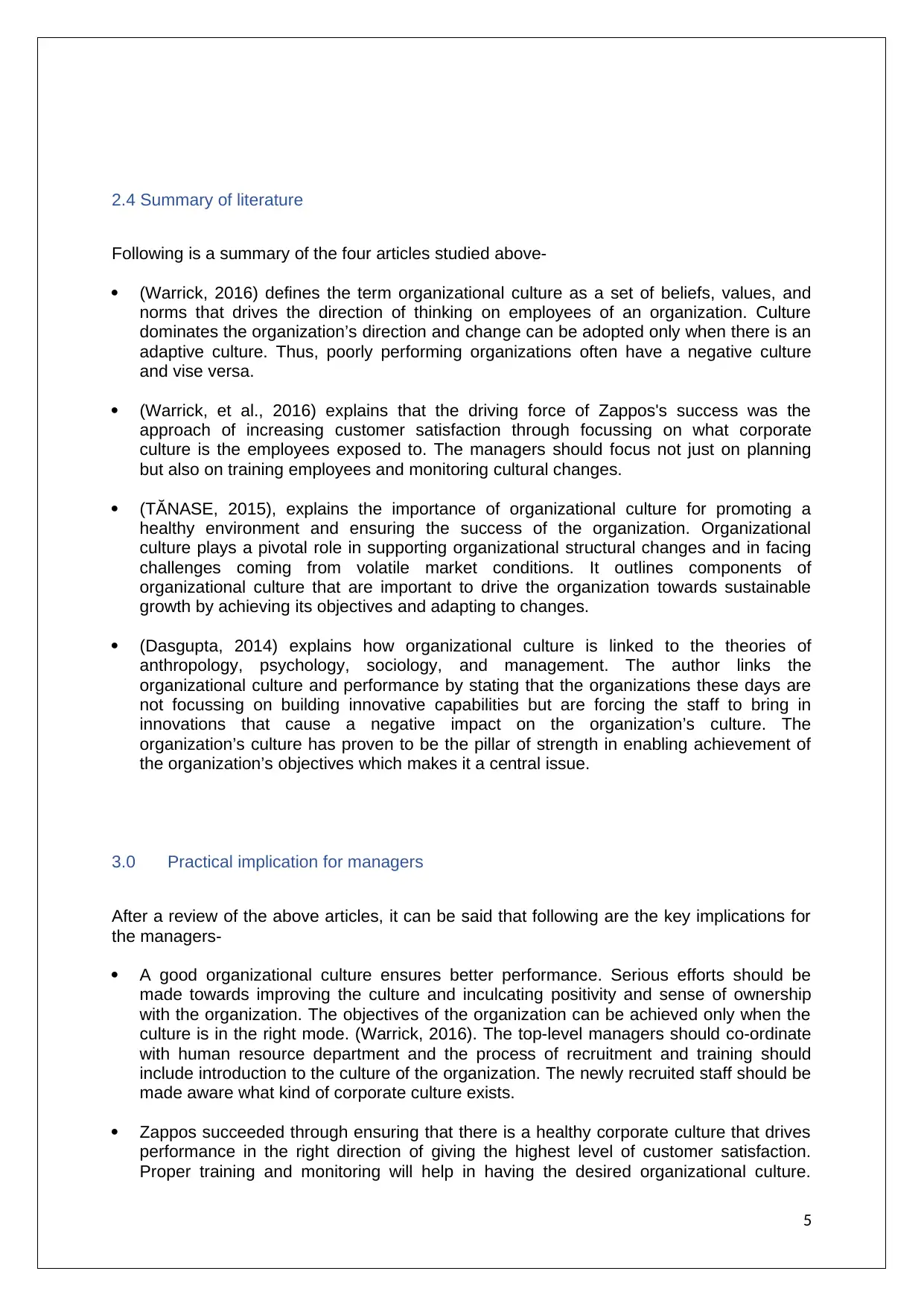
2.4 Summary of literature
Following is a summary of the four articles studied above-
(Warrick, 2016) defines the term organizational culture as a set of beliefs, values, and
norms that drives the direction of thinking on employees of an organization. Culture
dominates the organization’s direction and change can be adopted only when there is an
adaptive culture. Thus, poorly performing organizations often have a negative culture
and vise versa.
(Warrick, et al., 2016) explains that the driving force of Zappos's success was the
approach of increasing customer satisfaction through focussing on what corporate
culture is the employees exposed to. The managers should focus not just on planning
but also on training employees and monitoring cultural changes.
(TĂNASE, 2015), explains the importance of organizational culture for promoting a
healthy environment and ensuring the success of the organization. Organizational
culture plays a pivotal role in supporting organizational structural changes and in facing
challenges coming from volatile market conditions. It outlines components of
organizational culture that are important to drive the organization towards sustainable
growth by achieving its objectives and adapting to changes.
(Dasgupta, 2014) explains how organizational culture is linked to the theories of
anthropology, psychology, sociology, and management. The author links the
organizational culture and performance by stating that the organizations these days are
not focussing on building innovative capabilities but are forcing the staff to bring in
innovations that cause a negative impact on the organization’s culture. The
organization’s culture has proven to be the pillar of strength in enabling achievement of
the organization’s objectives which makes it a central issue.
3.0 Practical implication for managers
After a review of the above articles, it can be said that following are the key implications for
the managers-
A good organizational culture ensures better performance. Serious efforts should be
made towards improving the culture and inculcating positivity and sense of ownership
with the organization. The objectives of the organization can be achieved only when the
culture is in the right mode. (Warrick, 2016). The top-level managers should co-ordinate
with human resource department and the process of recruitment and training should
include introduction to the culture of the organization. The newly recruited staff should be
made aware what kind of corporate culture exists.
Zappos succeeded through ensuring that there is a healthy corporate culture that drives
performance in the right direction of giving the highest level of customer satisfaction.
Proper training and monitoring will help in having the desired organizational culture.
5
Following is a summary of the four articles studied above-
(Warrick, 2016) defines the term organizational culture as a set of beliefs, values, and
norms that drives the direction of thinking on employees of an organization. Culture
dominates the organization’s direction and change can be adopted only when there is an
adaptive culture. Thus, poorly performing organizations often have a negative culture
and vise versa.
(Warrick, et al., 2016) explains that the driving force of Zappos's success was the
approach of increasing customer satisfaction through focussing on what corporate
culture is the employees exposed to. The managers should focus not just on planning
but also on training employees and monitoring cultural changes.
(TĂNASE, 2015), explains the importance of organizational culture for promoting a
healthy environment and ensuring the success of the organization. Organizational
culture plays a pivotal role in supporting organizational structural changes and in facing
challenges coming from volatile market conditions. It outlines components of
organizational culture that are important to drive the organization towards sustainable
growth by achieving its objectives and adapting to changes.
(Dasgupta, 2014) explains how organizational culture is linked to the theories of
anthropology, psychology, sociology, and management. The author links the
organizational culture and performance by stating that the organizations these days are
not focussing on building innovative capabilities but are forcing the staff to bring in
innovations that cause a negative impact on the organization’s culture. The
organization’s culture has proven to be the pillar of strength in enabling achievement of
the organization’s objectives which makes it a central issue.
3.0 Practical implication for managers
After a review of the above articles, it can be said that following are the key implications for
the managers-
A good organizational culture ensures better performance. Serious efforts should be
made towards improving the culture and inculcating positivity and sense of ownership
with the organization. The objectives of the organization can be achieved only when the
culture is in the right mode. (Warrick, 2016). The top-level managers should co-ordinate
with human resource department and the process of recruitment and training should
include introduction to the culture of the organization. The newly recruited staff should be
made aware what kind of corporate culture exists.
Zappos succeeded through ensuring that there is a healthy corporate culture that drives
performance in the right direction of giving the highest level of customer satisfaction.
Proper training and monitoring will help in having the desired organizational culture.
5
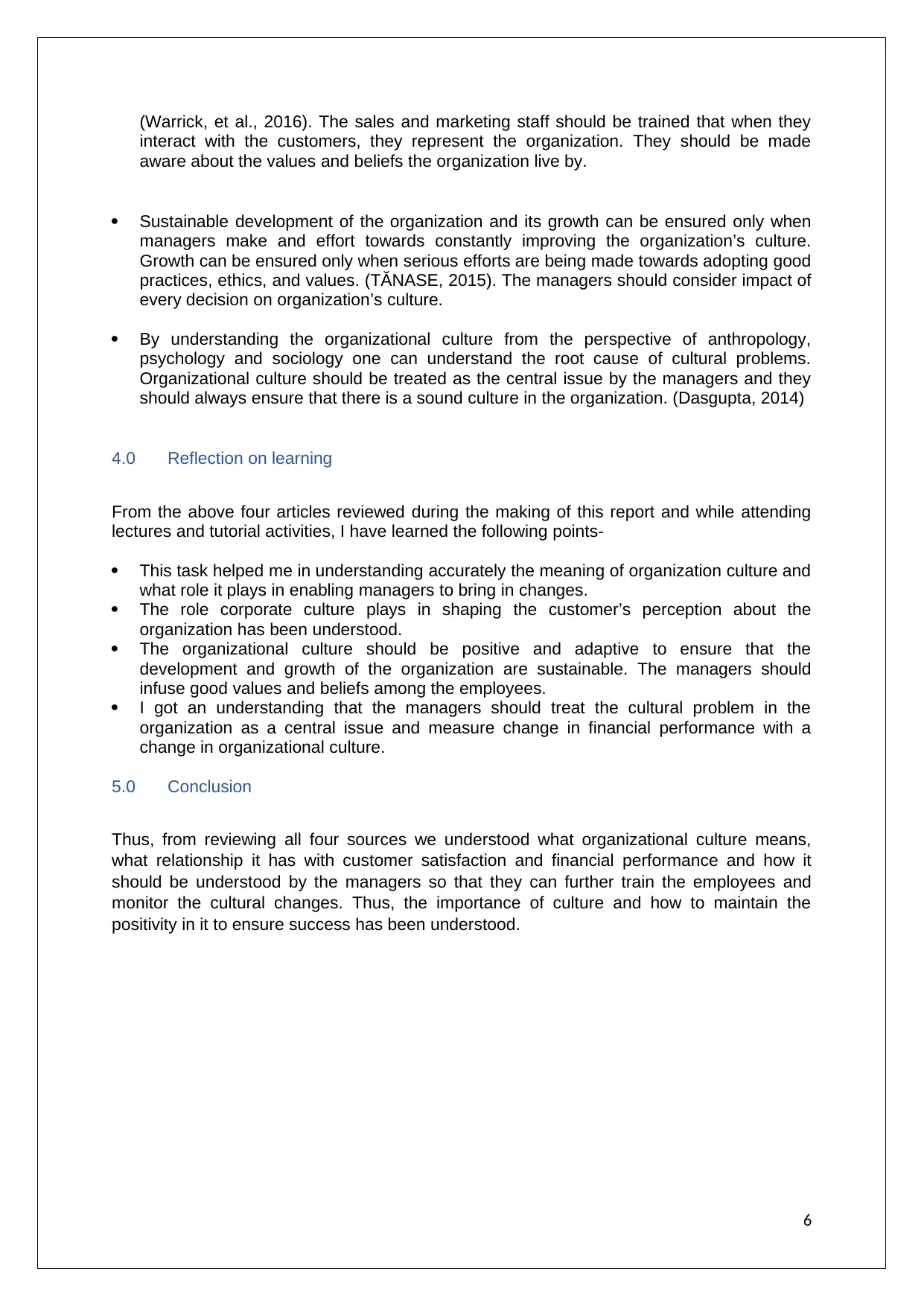
(Warrick, et al., 2016). The sales and marketing staff should be trained that when they
interact with the customers, they represent the organization. They should be made
aware about the values and beliefs the organization live by.
Sustainable development of the organization and its growth can be ensured only when
managers make and effort towards constantly improving the organization’s culture.
Growth can be ensured only when serious efforts are being made towards adopting good
practices, ethics, and values. (TĂNASE, 2015). The managers should consider impact of
every decision on organization’s culture.
By understanding the organizational culture from the perspective of anthropology,
psychology and sociology one can understand the root cause of cultural problems.
Organizational culture should be treated as the central issue by the managers and they
should always ensure that there is a sound culture in the organization. (Dasgupta, 2014)
4.0 Reflection on learning
From the above four articles reviewed during the making of this report and while attending
lectures and tutorial activities, I have learned the following points-
This task helped me in understanding accurately the meaning of organization culture and
what role it plays in enabling managers to bring in changes.
The role corporate culture plays in shaping the customer’s perception about the
organization has been understood.
The organizational culture should be positive and adaptive to ensure that the
development and growth of the organization are sustainable. The managers should
infuse good values and beliefs among the employees.
I got an understanding that the managers should treat the cultural problem in the
organization as a central issue and measure change in financial performance with a
change in organizational culture.
5.0 Conclusion
Thus, from reviewing all four sources we understood what organizational culture means,
what relationship it has with customer satisfaction and financial performance and how it
should be understood by the managers so that they can further train the employees and
monitor the cultural changes. Thus, the importance of culture and how to maintain the
positivity in it to ensure success has been understood.
6
interact with the customers, they represent the organization. They should be made
aware about the values and beliefs the organization live by.
Sustainable development of the organization and its growth can be ensured only when
managers make and effort towards constantly improving the organization’s culture.
Growth can be ensured only when serious efforts are being made towards adopting good
practices, ethics, and values. (TĂNASE, 2015). The managers should consider impact of
every decision on organization’s culture.
By understanding the organizational culture from the perspective of anthropology,
psychology and sociology one can understand the root cause of cultural problems.
Organizational culture should be treated as the central issue by the managers and they
should always ensure that there is a sound culture in the organization. (Dasgupta, 2014)
4.0 Reflection on learning
From the above four articles reviewed during the making of this report and while attending
lectures and tutorial activities, I have learned the following points-
This task helped me in understanding accurately the meaning of organization culture and
what role it plays in enabling managers to bring in changes.
The role corporate culture plays in shaping the customer’s perception about the
organization has been understood.
The organizational culture should be positive and adaptive to ensure that the
development and growth of the organization are sustainable. The managers should
infuse good values and beliefs among the employees.
I got an understanding that the managers should treat the cultural problem in the
organization as a central issue and measure change in financial performance with a
change in organizational culture.
5.0 Conclusion
Thus, from reviewing all four sources we understood what organizational culture means,
what relationship it has with customer satisfaction and financial performance and how it
should be understood by the managers so that they can further train the employees and
monitor the cultural changes. Thus, the importance of culture and how to maintain the
positivity in it to ensure success has been understood.
6
⊘ This is a preview!⊘
Do you want full access?
Subscribe today to unlock all pages.

Trusted by 1+ million students worldwide
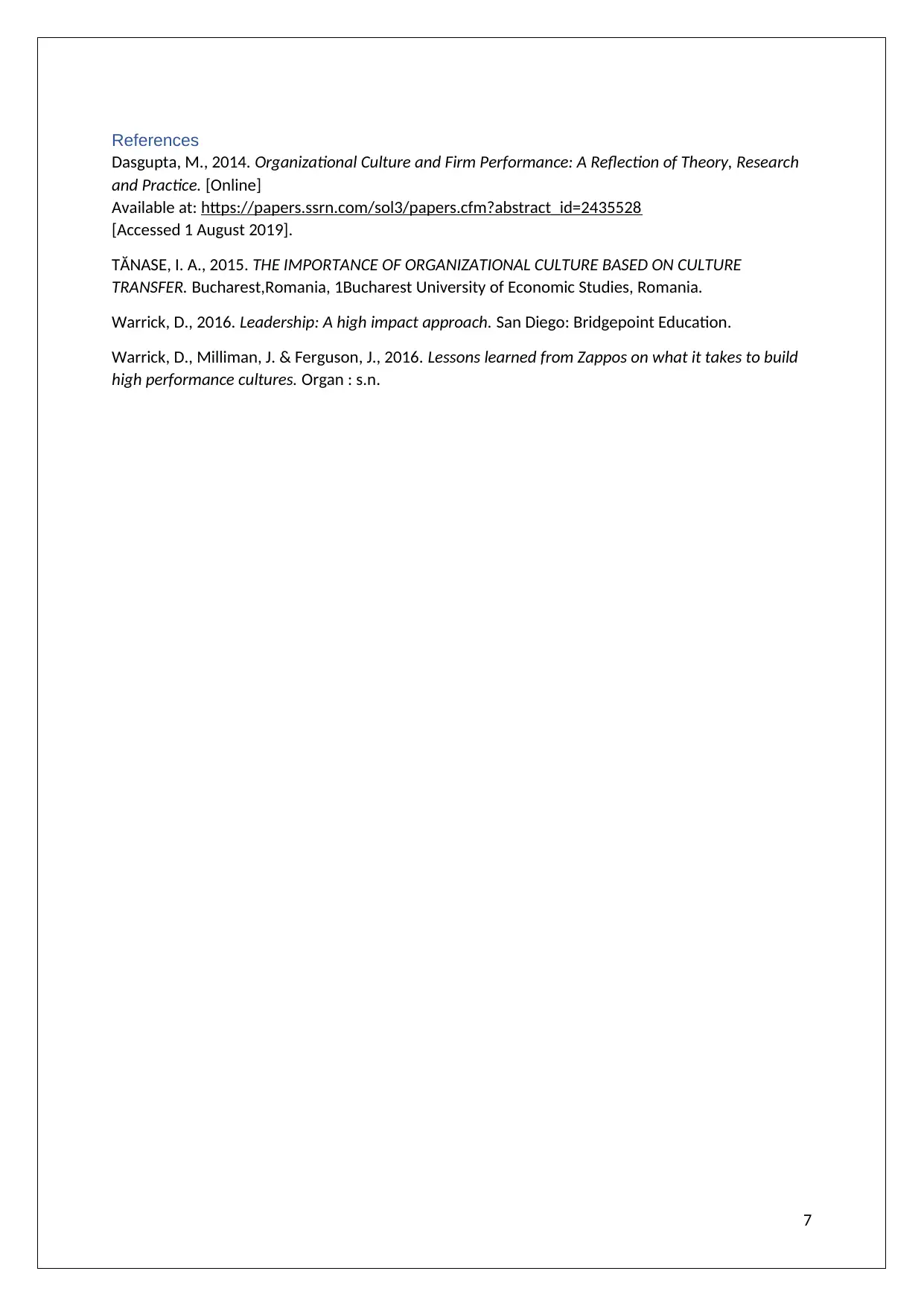
References
Dasgupta, M., 2014. Organizational Culture and Firm Performance: A Reflection of Theory, Research
and Practice. [Online]
Available at: https://papers.ssrn.com/sol3/papers.cfm?abstract_id=2435528
[Accessed 1 August 2019].
TĂNASE, I. A., 2015. THE IMPORTANCE OF ORGANIZATIONAL CULTURE BASED ON CULTURE
TRANSFER. Bucharest,Romania, 1Bucharest University of Economic Studies, Romania.
Warrick, D., 2016. Leadership: A high impact approach. San Diego: Bridgepoint Education.
Warrick, D., Milliman, J. & Ferguson, J., 2016. Lessons learned from Zappos on what it takes to build
high performance cultures. Organ : s.n.
7
Dasgupta, M., 2014. Organizational Culture and Firm Performance: A Reflection of Theory, Research
and Practice. [Online]
Available at: https://papers.ssrn.com/sol3/papers.cfm?abstract_id=2435528
[Accessed 1 August 2019].
TĂNASE, I. A., 2015. THE IMPORTANCE OF ORGANIZATIONAL CULTURE BASED ON CULTURE
TRANSFER. Bucharest,Romania, 1Bucharest University of Economic Studies, Romania.
Warrick, D., 2016. Leadership: A high impact approach. San Diego: Bridgepoint Education.
Warrick, D., Milliman, J. & Ferguson, J., 2016. Lessons learned from Zappos on what it takes to build
high performance cultures. Organ : s.n.
7
1 out of 7
Related Documents
Your All-in-One AI-Powered Toolkit for Academic Success.
+13062052269
info@desklib.com
Available 24*7 on WhatsApp / Email
![[object Object]](/_next/static/media/star-bottom.7253800d.svg)
Unlock your academic potential
Copyright © 2020–2025 A2Z Services. All Rights Reserved. Developed and managed by ZUCOL.





